|
Summary: LDS Scripture suggests that
Noah built the ark
in America, land of his emigrant forebearers. LDS Scripture also tells us
that the ark came to rest on a mountain (hills) in the land of Ararat (Urartu,
ancient Armenia). According to scripture, there was flooding at both
locations. How can that be if “the floods” mentioned in the Book of Moses,
did not truly cover all land masses? A possible answer is that there was massive flooding in America, and in the Black Sea region at about the same time.
Both floods may have been linked to a similar, if not a common cause.
“And this is the genealogy
of the sons of Adam, who was the son of God, with whom God, himself,
conversed.” (Moses 6:22)
The American Adam idea was not unique to Mormonism. Members of the early LDS Church were keenly aware of
Josiah Priest’s 1833 bestseller
American Antiquities and Discoveries in the West. In his work,
Priest highlights the opinion of Dr. Samuel L. Mitchell of New York. This was the same Dr. Mitchell who, according to
Martin Harris, performed the service of sanctioning the authenticity of a sample of characters copied from the
Book of Mormon plates.
(History of the Church 1:20) It was Dr. Mitchell’s considerate opinion that Adam was created in ancient America.
Priest explains:
“The celebrated antiquarian, Samuel L. Mitchell, late of New York, with other gentlemen, eminent for their knowledge of natural history, are even of the opinion, that America was the country where ADAM was created.”
(American Antiquities, 1833 edition, pg. 129);
Priest hastens to add that Eden must have been in the Eastern Hemisphere. To suppose
otherwise contradicts “the statement of Moses, in the Book of Genesis; …stating the names of the very rivers, arising out of the regions of country …”
Readers of Hebrew scripture recognize that all the names of lands associated
with the rivers of Eden, are names of descendents of
Noah.
See Moses 3:10-15,
and Bereshit (Gen.) 2:8-14;
10:7;
25:18.
The land of Havilah, for instance, relates to the name of a descendent of Kush son of
Ham, and is also the name of a descendent of Shem.
The land of Kush is
presumptuously translated “Ethiopia” in Gentile
Bibles.
This overlooks ancient Mesopotamian lands bearings the same name. Had the translators
who produced the Greek Septuagint
translated “Kush”
(כּוּשׁ) as “Chus” (Χούς)
in Genesis II.13,
as they did in the case of Genesis X.6, then
Genesis 2:13 (King James Version) would have likely read “Cush”,
as in Genesis 10:6 (KJV),
and the Joseph Smith Translation, which relied on the KJV, would
have very likely
read “Cush” in Moses 3:13,
instead of “Ethiopia”.
The point is, when you read “Ethiopia” in LDS Scripture, think
“Kush”, which is not
necessarily the same as Ethiopia
in every instance. God apparently allowed English LDS Scripture to be expressed in terms of imperfect
KJV terminology, so that those who truly seek, may more readily trace
the imperfect terms back to more perfect terms - the ancient terminology behind the KJV.
(Mormon 9:33)
The land of Ashur
(second son of Shem) near Eden, is
translated “Assyria”
(Genesis 2:14, KJV,
Moses 3:14).
The Bible is clearly not referring to a land in ancient America.
But, Moses chapter 3 footnote 13a (1979, 2013 edition) reads:
“In the area of Eden and Adam-ondi-Ahman
there were rivers and lands that received names that were later attached to
other lands and rivers. As to the location of Eden and its environs,
see D&C 117:8-9.
Gen. 2:13.”
Contrary to what this footnote seems to suggest, none of the scriptures cited in the footnote
explicitly state that Eden was in America. While the land of Adam-ondi-Ahman is
clearly placed in North America, Eden is not! To give the benefit of the doubt
to church committee members who reviewed, and approved this footnote, we may
suppose
that they did not understand that the ancient names of the lands cited in
Moses 3:10-14
(Bereshit (Gen.) 2:10-14)
were tied to names of people born after the flood.
The
“Hidekel”
(חִדֶקֶל)
and “Perat”
(פְרָת) rivers of
Eden named in Bereshit (Gen.) 2:14
(Moses 3:14)
are none other than the famous Tigris and Euphrates of Mesopotamia.
The recent footnote (a) added to Moses 3:13 appears to be an
attempt to reconcile the American Eden tradition promulgated by Brigham Young,
with portions of Joseph Smith’s translation of the Bible (1830,
in English). Joseph Smith’s translation did not
become available in its entirety until 1867 (via the RLDS
Church). Brigham Young had by then, anchored in the minds of the saints the
unscriptural American Eden tradition.
Hebrew prophets were not confused about Eden’s general location. See for
example YehezqEl (Ezek.) 31:16-18.
Eden’s Fertile Crescent
proximity is well established in scripture. It is important for students of
LDS scripture to come to terms with the fact that the garden from which Adam was expelled was indeed “eastward in Eden”.
The question to ask is, “eastward” with respect to where? With respect to where the great law giver was? With respect to where Adam was created?
Even though the name “Eden” has become synonymous with
“Paradise”, scripture does not say that the biblical garden of God occupied the entire
fertile plain, or region that was Eden. The garden of God was “in Eden”.
(Bereshit (Gen.)
2:8) Eden appears to have included northern portions of the Fertile Crescent,
hence YehezqEl (Ezek.)
31:16-18. Not all the trees of Eden were necessarily in the garden.
What does “Eden” mean?
In Hebrew, “Eden” (עֵדֶן) has come to mean
delight, but the word may relate to a more ancient Middle-Eastern term
having to do with a
fruitful, or
fertile plain.
(Brown-Driver-Briggs-Gesenius Hebrew-Aramaic Lexicon, 4574, 5731, pp. 726-727)
Curiously, Priest was willing to concede the possibility that some of Adam’s immediate posterity
left the region of Eden and settled in America.
Priest elaborates:
“It is not impossible but America may have been the country where Noah built his ark, as directed by the Most High.
We know very well, when the mind refers to the subject of Noah's Ark, our thoughts are immediately associated with Mount Ararat, because it rested there, on the subsiding of the flood. But this circumstance precludes a possibility of its having been built there, if we allow the waters of the deluge to have had any current at all. It is said in Genesis, that the Ark floated, or was borne upon the waters above the earth, and also, that the ark "went upon the face of the waters.'' From which fact we imagine there must have been a current, or it could not have went upon the waters.
Consequently, it went from the place where it was built, being obedient to the current of the waters.
Now, if it had been built anywhere in the country called Armenia, where the mountain Ararat is situated ; and as it is found the waters had a general eastern direction, the Ark in going on the face of the waters, would have, during the time the waters of the deluge prevailed, which was an hundred and fifty days, or five months, (that is, prevailed after the commencement of the deluge, till its greatest depth was effected;) gone in an eastern direction as far perhaps as the region of the islands of Japan, beyond China, east, a distance of about six thousand miles from Ararat, which would be at the rate of about forty miles a day, or if it had floated faster, would have carried it into the Pacific Ocean.
But if we may imagine it was erected in North America, or somewhere in the latitude of the State of New-York, or even farther west, the current of the deluge would have borne it easterly. And suppose it may have been carried at the rate of forty or fifty miles a day, would, during the time the waters prevailed, in which time, we may suppose, a current existed, have progressed as far as to Ararat; a distance of nearly six thousand miles from America, where it did actually rest-
More than sixteen hundred years had elapsed, when the ark was finished, and it may fairly be inferred, that as Noah was born about one thousand years after the creation of the world, that mankind had from necessity, arising from the pressure of population, gone very far away from the regions round about Eden; and the country where Noah was born may as well be supposed to have been America, as any other part of the earth; seeing there are indubitable signs of antediluvian population in many parts of it. Unite this circumstance with that of the ascertained current of the deluge from America, and with the fact of the ark's having rested in an easterly direction from this country, we come to a conclusion, that here, perhaps in the very State of New-York, the miraculous vessel was erected, and bore away, treasured in its enormous capacity, the progenitors of the human race renewed. So that if America have not the honor of being the country where Adam was created, as is believed by some, it has nevertheless the honor, as we suppose, of being the country where the ark was erected.”
(Josiah Priest, American Antiquities, 1833
edition, pp. 130-131; emphais added.)
Scripture brought forth by the Prophet Joseph Smith reconciles Priest’s and Dr. Mitchell’s published opinions on Eden and Adam. Though
we have no firsthand statement by the Prophet on the subject, Joseph Smith probably taught that
Adam was created (begotten) in North America. LDS Scripture indicates that the bodies of the man and the woman were formed from ground that was separate and apart from the eastern garden.
(Alma 42:2) Adam, the immortal son of God was at some point placed in the “garden eastward in Eden”, the same
Fertile Crescent garden described by God to his prophet Mosheh
(“Moses”; see
Moses 3:10-15).
Scripture indicates that there were
people in both hemispheres, long before the time of
Noah.
(E.g. Moses 7:22-24)
After Adam transgressed, he was expelled from the eastern garden to “till the ground from whence he was taken” (“ground” located in North America,
Moses 4:29,
LDS Doctrine and Covenants 78:15
107:53-57;
116:1;
117:8). LDS scripture clearly places Adam in North America sometime after his expulsion from the Garden of Eden.
It
is also clear that Adam did not immediately arrive in America after his
expulsion. Adam’s firstborn was not Qayin
(קַיׅן,“Cain”),
as commonly supposed. Qayin “with his wife, and many of his brethren dwelt in the land of
Nod, on the
east of Eden.”
(Moses 5:41)
There is no puzzlement in LDS scripture over where Qayin’s wife came from.
(Moses 5:1-4;
28)
Qayin apparently slew his brother Hevel (הֶבֶל, “Abel”)
in the Eastern Hemisphere. In time, Adam and some of his descendents emigrated to America.
Right or wrong, W. W. Phelps remarked, “… the Adamites, or, at least, some Cainites, had the world to themselves about 1600 years before the flood.” (EVENING AND MORNING STAR, Vol. I, August, 1832. No. 3, pg. 22)
The antediluvian promised land of Qenan (קֵינָן, “Cainan”),
not mentioned in the Bible, must have been in America.
(Moses 6:17,
41-43)
Qenan should not be confused with
Kena'an (כְנׇעַן, “Canaan”;
see LDS Doctrine and Covenants 107:45,
53).
The edited Inspired Version of the Bible gives the
impression that the Prophet Joseph Smith intended “Cainan” in verses that
would later be published as
Moses 7:6-12.
(See Inspired Version, Genesis 7:6-14)
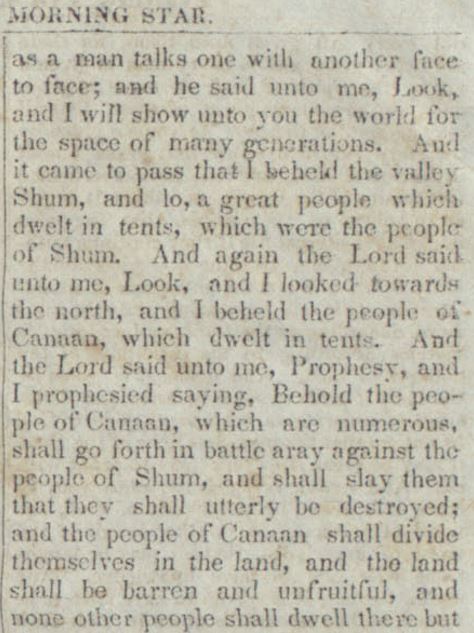
“Extract from the Prophecy of Enoch”,
The Evening and the Morning Star, Vol. 1, Aug. 1832, pg. 44. Note the use
of “Canaan”, as in Moses 7:6-12. “Canaan”
exists in the Bible as a post-flood name. The same passage in the
edited Joseph Smith
Translation of the Bible (Inspired Version, Genesis 7:6-14) reads “Cainan”
instead.
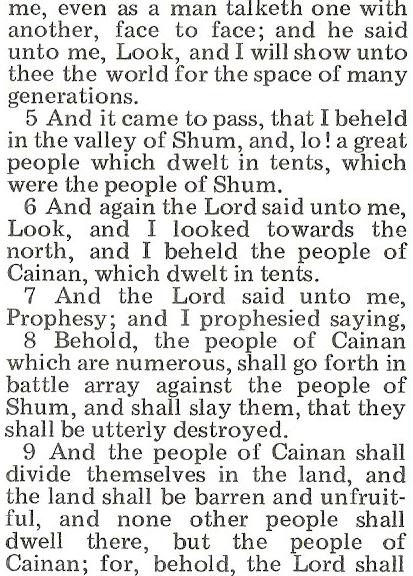
Edited JST Genesis 7:4-9 (Inspired Version), featuring the antediluvian
name “Cainan”. The Joseph Smith OLD TESTAMENT MANUSCRIPT 1, Page 13
(Moses 6:34-52) reads “the land of Cainan by the sea east” (Atlantic? Moses 6:42), whereas OLD TESTAMENT MANUSCRIPT 2, Page 17 (Moses 6:40-53) reads, “the land of Canaan, by the Sea East”.
(JOSEPH SMITH’S NEW TRANSLATION OF THE BIBLE - ORIGINAL MANUSCRIPTS, Edited by Scott H. Faulring,
Kent P. Jackson, and Robert J. Matthews, pp. 100, 611) This manuscript error leads
one to wonder if all references to “Canaan” in the Pearl of Great Price Book of Moses should read
“Cainan” instead. Can
the warlike “people of Cainan” be interpreted “people of spears”?
This interpretation makes more sense of Moses 7, than “Canaan”.
In establishing the American Eden idea, it is unlikely that President Brigham Young considered
Moses 3:10-15,
which was revealed through the Prophet Joseph Smith (1830). This scripture
did not become available to members of the LDS Church until decades later, via Elder
Franklin D. Richards
(Millennial Star, March 15, 1851, England).
Robert J. Matthews notes, “Elder
Richards does not state how he obtained this latest material, but he must
have had a handwritten source for it, since most of it had never before been
printed.”
(“How We Got the Book of Moses”)
Heber C. Kimball
related that “The Prophet Joseph frequently spoke of these things [Adam in an American garden] in the revelations which he gave, but the people generally did not understand them ...”
(Journal of Discourses, 10:235, Remarks by President Heber C. Kimball, delivered in Provo City, June 27, 1863, Reported by J. V. Long)
Those who did not fully understand what Joseph taught on the subject of Adam
in America, probably included church leaders. An early Mormon hymn features the line:
“For in Adam-ondi-Ahman Zion rose where Eden was” (William W. Phelps, “Glorious Things Are Sung of Zion”,
LDS Hymns, 48, 2nd verse) Compare Yesha'Yahu (Is.) 51:3.
It appears that President Brigham Young, and others, conflated the American “Eden” (fertile plain) where Adam was born, with the scriptural Garden of Eden
from which Adam was expelled.
Relying somewhat on his own understanding, which he admitted was “in part”, Brigham Young
also conflated God the Father,
“ADAM QODESH” (אדם־קֺדש),
“MAN OF HOLINESS”
(who came into the American garden with a celestial companion), with his son Adam, who transgressed and was expelled with his companion from the scriptural, eastern garden:
“Now hear it, O inhabitants of the earth, Jew and Gentile, Saint and sinner!
When our father Adam came into the garden of Eden, he came into it with a
celestial body, and brought Eve, one of his wives, with him. He helped to
make and organize this world. He is MICHAEL, the Archangel, the ANCIENT OF
DAYS! about whom holy men have written and spoken—HE is our FATHER and our
GOD, and the only God with whom WE have to do. … When the Virgin Mary
conceived the child Jesus, the Father had begotten him in his own likeness.
… And who is the Father? He is the first of the human family; and when he
took a tabernacle, it was begotten by his Father in heaven, after the same
manner as the tabernacles of Cain, Abel, and the rest of the sons and
daughters of Adam and Eve; from the fruits of the earth, the first earthly
tabernacles were originated by the Father, and so on in succession. I could
tell you much more about this; but were I to tell you the whole truth,
blasphemy would be nothing to it, in the estimation of the superstitious and
over-righteous of mankind. However, I have told you the truth as far as I
have gone. … Treasure up these things in your hearts. In the Bible, you have
read the things I have told you to-night; but you have not known what you
did read. I have told you no more than you are conversant with; but what do
the people in Christendom, with the Bible in their hands, know about this
subject? Comparatively nothing.” (“—Adam, Our
Father and Our God”, A sermon delivered by President Brigham Young,
in the Tabernacle, Great Salt Lake City, April 9, 1852; emphasis
added.)
President Young further remarked:
“Though we have it in history that our father Adam was made of the dust of this earth, and that he knew nothing about his God previous to being made here, yet it is not so; and when we learn the truth we shall see and understand that he helped to make this world, and was the chief manager in that operation.
He was the person who brought the animals and the seeds from other planets to this world, and brought a wife with him and stayed here.
You may read and believe what you please as to what is found written in the Bible. Adam was made from the dust of an earth, but not from the dust of this earth. He was made as you and I are made, and no person was ever made upon any other principle.
Do you not suppose that he was acquainted with his associates, who came and helped to make this earth? Yes, they were just as familiar with each other as we are with our children and parents.”
(Journal of Discourses, 3:319, A Discourse by President Brigham Young, Delivered in the Tabernacle, Great Salt Lake City, April 20, 1856;
emphasis added)
It seems as though Brigham Young (1801-1877) was not aware, when he first expounded his
interpretation of the Adam-God revelation, of that portion of the Joseph Smith
Translation in which God made known that Adam (who transgressed), was sent “forth from the Garden of Eden, to till the ground from whence he was taken”?
(Moses 4:28-30)
The understanding that Adam was materially formed, born and raised in ancient
America, and later placed “eastward in Eden ”, accords with LDS scripture.
The concept that Adam was made of the dust of another world, is true in the case
of the MAN (ADAM) who is God the Father.
LDS Apostle Bruce R. McConkie,
having repented of doctrinal errors himself, remarked:
“Some prophets -- I say it respectfully – know more and have greater inspiration than others. Thus, If Brigham Young who was one of the greatest of the prophets, said something about Adam which is out of harmony with what is in the Book of Moses and in Section 78, it is the scripture that prevails. This is one of the reasons we call our scriptures
The Standard Works. They are the standard of judgment and the measuring rod against which all doctrines and views are weighed, and it does not make one particle of difference whose views are involved. The scriptures always take precedence.”
(McConkie, “Honest Seekers of Truth”, 1 July, 1980; see also STANDARD WORKS, Mormon Doctrine, pp. 764-765; and Dennis B. Horne, Bruce R. McConkie Highlights From His Life & Teachings, pp. 143-144; emphasis added)
The Joseph Smith Translation of the Bible (Inspired Version) was published in its entirety in 1867. (Robert J. Matthews, “How We Got the Book of Moses”) This was many years after Brigham Young first announced his understanding of the American Eden, and the Adam-God revelation. It is now obvious from revealed scripture, that Adam, who was sent forth from Eden to “till the ground from whence he was taken”, is distinct from the exalted MAN (his Father) who descended into an American garden from another world.
(Moses 6:51-52, see also Alma 42:2)
The body of the being we typically think of as Adam, was indeed made of the dust of this
earth. When his celestial parents (Mother in particular) partook of the fruits of the American
garden, they assimilated earthly material which went into forming the
developing body of their child. When their son Adam was sufficiently
mature, he was placed in a “garden eastward in Eden [Fertile Crescent]”.
Thus, the one we typically think of as Adam, is the immortal son of God who
became mortal by transgression. Scripture does not explain in detail the biological mechanism of this change, only that it happened.
(1 Corinthians 15:21-22,
2 Nephi 2:22-23)
Yeshua (the Savior’s Hebrew name, the name his parents called
him) is the immortal Mashiah
(Anointed One), the Only Begotten Son of MAN OF HOLINESS
(ADAM QODESH)
born in mortality. (Luke 22:67-70)
As a mortal man (“enosh”) the Son of MAN
(“Ben ADAM”) was made a little lower than the “Elohim”.
(Tehilim (Ps.) 8:4-5)
But, resurrected Yeshua is both an Adam and one of the Elohim.
(Tehilim (Ps.)
82:6-7) This understanding is central to the Apostle Paul’s Adam-God (Lord from heaven)
teaching; which some monotheistic religions find offensive. (1 Corinthians 15:45-49)
History of the Church records a statement attributed to the
Prophet Joseph Smith, which he made during a sermon at the grove, east of the
Temple site in Nauvoo (June 1844):
“I learned a testimony concerning Abraham. and he reasoned concerning the God of heaven. "...Intelligences
exist one above another, so that there is no end to them."
If Abraham reasoned thus - If Jesus Christ was the son of God, and John discovered that God the Father of Jesus Christ had a Father, you may suppose that
He had a Father also. Where was there ever a son without a father? And where was there ever a father without first being a son?
Whenever did a tree, or anything spring into existence without a progenitor? And everything comes in this way. Paul says that which is earthly in the likeness of that which is heavenly.
Hence if Jesus had a Father, can we not believe that He had
a Father also? I despise the idea of being scared to death of such a
doctrine, for the Bible is full of it.” (History of the Church 6:476)
In answer to the Sunday School version of the old “Which came first ..?” conundrum;
Yes, Adam had a navel! His father was God
the Eternal Father, and his mother was she who is, and was truly
“mother of all living” חוה.
(Moses 4:26)
Adam son of God
(Luke 3:38,
Moses 6:22)
simply called his own wife after a name by which his divine Mother was called.
(Bereshit (Gen.)
3:20) The Apostle Paul’s statement that “the man is not of the woman; but
the woman of the man” is true in the sense that Adam was not begotten by his
wife, though she was indeed begotten by immortal man. Moreover, Adam is exactly in the image and glory of his father, whereas the woman
is more exactly in the image and splendor of her divine mother. Together, husband
and wife are called “Adam”.
(1 Corinthians 11:7-12,
Bereshit (Gen.)
5:2)
For some reason, the inspired passages of
Abraham 5:10-11,
revealed in the Nauvoo period, did not feature the geographic detail present in
Moses 3:10-15.
(See “The Book of Abraham”, Times and Seasons, March 15, 1842, Volume 3, pg. 722)
The fact that the Book of Abraham Garden of Eden account does not feature the geographic detail found in
Bereshit (Gen.) 2:11-14
(Moses 3:11-14),
should not be construed as evincing the footnote recently attached to
Moses 3:13. If, as the footnote insists, the names of rivers and lands were antediluvian, then why were they not passed down in the
Book of Abraham account? Rather - the absence of these geographic names in
Abraham 5:10-11, may
simply indicate that not all of the lands listed in Bereshit (Gen.) 2:11-14, went by the same post-flood names in Avraham’s
time, that later identified them in the time of Mosheh (Moses).
Regardless of when the post-flood rivers and lands assumed their biblical names, Moses 3 rightly stands today as authoritative LDS scripture – a direct communication from God to
his son Mosheh (Moses). Combined with available Hebrew scripture, we have sufficient witness and grounds for placing Eden where Hebrew scripture says it was - in the vicinity of
the Fertile Crescent. We may consider that there was an Eden like garden in
ancient America, but it was not the biblical “garden eastward in Eden”.
Because Brigham Young, and others, misunderstood Joseph’s comments about the garden of God in America, and confused the American fertile ground where Adam was
formed, with the biblical Garden of Eden, the American Eden tradition became
doctrine in the LDS Church. When Brigham Young conflated the Man of Holiness, who is God the Father, with his son Adam, who was made
(begotten)
in the image of God, the partially inspired but misleading Adam-God
interpretation was born. Neither of these interconnected teachings (American
Eden and Adam-God) completely squares with LDS scripture. But the sacred
truths in these teachings are reconcilable with scripture. For more see “Where was Eden? Where is the Garden of God?”
and “Son of Elohim and Man - The Son of Gods' Participation in the Creation of Adam”.
Understand that Brigham Young did not deliberately lead members of the Church astray from the oracles of God.
(Official Declaration - 1
... Excerpts from Three Addresses by President Wilford Woodruff Regarding the Manifesto)
He was allowed to expound his partially inspired opinions for many years. Notwithstanding the inaccuracies in his teachings, the Church headquartered at Salt Lake City has never had a more courageous prophet, one who has tried harder to promote the teachings of Joseph Smith as he understood them.
In summary, LDS scripture clearly places Eden in the Fertile Crescent, and Adam and
many of their direct descendants in temperate North America, in a land which to God, is “choice above all other lands” of this planet.
(2 Nephi 10:19) This
is where the scriptural land of Adam-ondi-Ahman is located.
(LDS Doctrine and Covenants 117:8-9)
It should come as no surprise then, that Joseph Smith may have taught that Noah and his family
built the ark at a location near the east coast of North America.
American Noah leads
to a sensible interpretation of scriptural flood accounts.
LDS scholar Ed Goble points out an account given by a Brother Huntington,
who claimed that “The place or country where the ark was built was designated in my hearing by the Prophet Joseph Smith as being in or near South Carolina.”
(The Young Women’s Journal, II, (December, 1890), pp. 124-125)
This secondhand statement attributed to the Prophet is intriguing.
It behooves us to investigate whether an ancient voyage from the east coast
of North America accords with the flood account found in Hebrew Scripture,
and with scientific possibility.
Publishing the views of naturalists of his day, Josiah Priest stated that “the
western lakes … Erie, Seneca, Cayuga, and many lesser ones, are the mere
remnants of the great inland sea which once existed in this region”.
(American Antiquities and Discoveries in the West, “FURTHER REMARKS ON THE DRAINING OF THE WESTERN COUNTRY OF ITS ANCIENT LAKES”, 1833 edition, pg. 370)
Referring to the American Promised Land of the Book of Mormon in
the vicinity of the Finger Lakes land Cumorah
(LDS Doctrine and Covenants 128:20,
Mormon 6:4-5), scripture states that “after the waters had receded from off the face of this land it became a choice land above all other lands, a chosen land of the Lord…”
(Ether 13:2)
It is a geological fact that there were great floods and
enormous inland seas
in antiquity, on both hemispheres. Massive floods occurred in ages past, the
likes of which the world has not seen since. But these were local baptisms
(washings) compared to the global inundation that
may have existed in the distant past.
It may be that long ago,
all of this dreary planet’s landmasses were covered with water. That is,
there may have been a time in the early ages of this earth, when
the planet was immersed
(baptized) fulfilling the description in Genesis 1:9. It is
also worth considering that many islands
emerged from the ocean separate from continents. (Moses 7:14) Islands came forth from
baptism at different times. The baptism of all lands need not be simultaneous. The more local baptism of “the
floods” of Noah washed away the wickedness of inhabited lands.
(1 Peter 3:18-21)
The Hebrew word “peleg” means “division”.
(E.g. Tehilim (Ps.) 55:9) The King James Bible records that in the days of Peleg “was the earth divided”.
(Genesis 10:25) It is true that the major continents were joined together and
sundered in prehistoric ages. But the division that took place in the days of Peleg the person, was a dispersing of peoples and languages upon the already divided
land.
(Bereshit (Gen.) 11:9, 16)
Before Peleg “the whole earth was of one language”
(referring to the inhabitants of an entire region,
Genesis 11:1, KJV)
See Note [א].
The Flood(s)
It is significant that the Pearl of Great Price Book of Moses tells of “the floods” (plural,
Moses 7:34,
38,
43,
50,
51;
8:17,
24);
whereas Hebrew scripture uses the singular word (proper noun)
“ha-mabul” (המבּוּל), translated “the flood”.
But, “ha-mabul” more literally means
the destruction, or the destructive storm
(Brown-Driver-Briggs-Gesenius Hebrew-Aramaic Lexicon, 3999, pg. 550).
What if the Hebrew flood account actually describes a North Atlantic voyage instigated by a prolonged torrential storm (“mabul”), or series of storms, resulting in massive flooding on the east coast of North America? What if the ocean voyage (in which all sight of land was lost from view for an extended period of time) was followed by a guided voyage through the
interconnected Mediterranean, Aegean,
Marmara and finally the Black Sea? What if the Black Sea region, with water pouring through the
Bosporus Strait, was also
undergoing a catastrophic deluge?
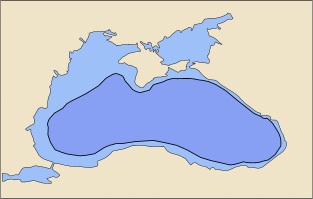
Black Sea today (light blue) and in ~5600
BCE (darker blue) according to a Black Sea Flood hypothesis
which
focuses on flooding through the Bosporus Strait.
What if there were other contributing mechanisms at work in Noah’s Flood(s)?
A catastrophic release of melt waters from northern snow and ice covered lands may help explain why “the waters of Noah shall no more go over the earth
[land]” (Yesha'Yahu (Is.) 54:9,
3 Nephi 22:9).
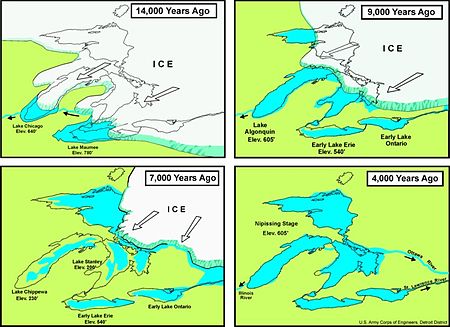
Laurentide Ice Sheet
in America. “… after the waters had receded from off the face of this land it became a choice land above all other lands, a chosen land of the Lord …”
(Ether 13:2)
Seeing an Old Story in a New/Old Way
Noah
(נֹחַ,“Noah”) means comfort or rest.
Hence the wordplay in Yesha'Yahu (Is.) 54:9-11,
3 Nephi 22:9-11.
The “waters of Noah [comfort, rest]” were to bring
“rest” to “the earth ... mother of men” by cleansing her from the
filthiness (the wickedness of the children of men) which had gone forth out of her.
(Moses 7:48-49)
Where there was no corrupt flesh, there was no need to destroy life by water.
(Yohanan (ST John)
13:10) What is more, the Eternal said in his heart
that he would never again smite all living things on land inhabited by the
wicked, as he did with the waters of the “mabul”. (Bereshit (Gen.)
8:21; note the word play with comforting, נִּיחֹחַ, translated “sweet”,
KJV)
Let’s re-examine the biblical flood story. Let’s try to see things as
members of Noah’s family, aboard the ark, might have seen things. As we focus on the
lines of scripture, let’s also try to resist popular imaginings of a world wide flood
covering all landmasses. Let’s go right to the Hebrew text, beginning with Bereshit (Gen.)
6:5. Readers may follow in the
King James Bible but are asked to consider Hebrew meanings behind key translated terms:
“And GOD [the Eternal]
saw that the wickedness of man [“ha-adam”, the man, mankind]
was great
[multiplied] ... And it repented [sorrowed] the LORD [the Eternal] that he had made man
[“ha-adam”, the man, mankind] on [in] the earth [land],
and it grieved [hurt] him at [to] his heart.” (Genesis 6:5-6, KJV)
The references to “GOD” and the “LORD” in the KJV are substitutions for the sacred name of
“the Eternal”
appearing in the Hebrew text. (Moses 7:35, Yesha'Yahu (Is.) 63:16,
Tehilim (Ps.) 110:1,
Yohanan (ST John)
5:43)
The expression imperfectly translated “repented” involves the root
“naham”,
meaning be sorry, give rest, comfort oneself. “Naham”
actually relates to the meaning of the name Noah.
(Bereshit (Gen.) 5:29)
Not comfortable with the King James translation in Genesis 6:5-6
(above), the Prophet Joseph Smith rendered the text to read:
“And God saw that the wickedness of men had become great ... And it repented Noah, and his heart was pained that the Lord had made man on the earth, and it
grieved him at his heart.”
(Moses 8:22, 25)
The Joseph Smith translation is also true, implicitly, though the
Hebrew text does not explicitly read this way.
The Hebrew account continues with Elohim (אֱלֺהִים,
“God”) speaking directly to Noah:
“And, behold, I, even I, do bring a [the] flood [destroying storm] of waters upon the earth [land],
to destroy all flesh, wherein is the breath of life, from under
[the] heaven; and every thing that is in the earth [land]
shall die [expire].” (Genesis 6:17, KJV)
God’s expression “ha-mabul mayim” translated “a flood of waters”
doesn’t come across as redundant in Hebrew. The word “mayim”, “waters”
following “ha-mabul” tells of “the destruction by waters” or “the destroying storm
of waters”).
The expression “al ha-arets”, which is translated “upon the earth”,
doesn’t necessarily mean global, or planet wide. The expression can simply mean “upon the land” referring to a local land or region similar to its use in Bereshit (Gen.) 41:56,
or Shemot (Ex.) 10:15,
21-23 etc.
See Note [א].
The destroying storm of waters did not destroy all flesh on the planet.
Aquatic life, for instance, survived. The “mabul” was designed to destroy (kol
ha-yequm .. me-al pene ha-adamah) “all standing life ... from off the face of the
ground” (Bereshit (Gen.) 7:4) of a region of land extending as far as the human eye could see (under the bowl of the sky) - all would “yigvah”, “expire” (breathe out), translated “die”(KJV).
Likewise all the animals and seed which the Eternal and Noah rescued in the
“tevah” (“ark”) consisted of varieties of breathing, creeping things of “ha-adamah” (the ground), and seed, from all the
local land, “kol ha-arets”, translated “all the earth”
(KJV).
(Bereshit (Gen.) 6:20;
7:3)
The Hebrew expression “mi-tahat ha-shamayim”
literally means “from under the heaven(s)”. But notice that the expression
implies an earthly, even human point of view in the use of the words “mi-tahat”,
“from under”. There is no definite up or down in outer space where divine
beings might view the globe.
“And it came to pass after seven days, that the waters of the flood [destructive storm]
were upon the earth [land].” (Genesis 7:10, KJV)
“In the six hundredth year of Noah's life, in the second month, the seventeenth day of the month, the same day were all the fountains of the great deep broken up, and the windows of heaven were opened.”
(Genesis 7:11,
KJV)
Here the ancient verse does not actually use the word “up” in any Hebrew
form. The reference to “all the fountains of the great deep” erupting,
bursting open, could describe the breaking of geological barriers that held
back water. The bursting might also apply to storm surge brought on by
cyclonic action. It might also have to do with massive waves caused by
impact(s) in the sea, or flooding brought on by
icy
comet, or meteor impacts on, or
bursting in the air above
remnant ice sheets in the north.
Could the seemingly metaphorical reference to the heaven(s) having “arubot”
(lattice like “windows”) have something to do with luminous streaks
appearing in the sky by crossing meteors? The Hebrew word “arubah”
is different than other words translated “window”. If you are interested in a comparison with other Hebrew words translated “window” in the Noah
account, see
Notes [ז , ח].
“And the rain was upon the earth forty days and forty nights.”
(Genesis 7:12,
KJV)
The Hebrew expression “arbaim yom v’arbaim laylah”, translated “forty days and forty nights” (KJV),
might possibly be interpreted “many a day and many a night”, and could be a subtle, poetic play on words,
or parallelism with “arubot ha-shamayim”, “the windows of heaven” (KJV).
The word “arbaim”, “forty” is masculine plural.
The word “arubot”, “windows” is feminine plural.
”And the flood [destruction] was forty days [many a day]
upon the earth [land]; and the waters increased, and bare up [lifted] the ark, and it was lift up
[raised] above the earth [land, ground].
And the waters prevailed, and were increased greatly upon the earth; and the ark went upon the face of the waters.”
(Genesis 7:17-18,
KJV)
Thus the “tevah”
(Egyptian loanword translated “ark”; sounds like the
modern Hebrew word for
“nature”)
was buoyed up, and went forth upon the face of the waters out to sea (ostensibly from
the ancient east coast of North America).
“And the waters prevailed [they were strong,
mighty] exceedingly upon the earth [land]; and all the
high hills, that were under the whole
[all] heaven
[heavens], were covered [concealed].
Fifteen cubits upward did the waters prevail; and the mountains were covered
[concealed].”
(Genesis 7:19-20,
KJV)
Fifteen “amah” (“cubits”) must refer to the draft of the great vessel, the distance from the vessel’s keel, or bottom to the waterline.
The ark was thirty “amah” high, so the great vessel was half submerged when fully loaded and afloat.
(Bereshit (Gen.)
6:15) We may think of the Hebrew word “tava” meaning sink, sink down, when thinking of
the “tevah”, “ark” as so very stable in the water.
The reference to the waters concealing all “he-harim ha-g’vohim”, translated “the high hills” (KJV) in verse 19 of chapter 7, as also the reference to
the concealing of “he-harim” translated “the mountains” (KJV)
in verse 20, is understandable in terms of the ark going far out to sea
- so far out that no hills, or mountains could be seen from the upper
story of the vessel. Mid-ocean, there was no sight of land anywhere, in
any direction, under the vast bowl of the sky! Again, a human
perspective is implied in the use of “tahat” (“under”), in “tahat kol
ha-shamayim” (under all the heavens).
The Hebrew root of the word translated “covered” in verses 19
and 20 is “kasah”.
This word can mean “conceal”. The horizon of a mighty ocean may conceal all sight of land.
The “mabul” (destroying storm) destroyed every living breathing inhabitant from “ha-arets”, translated “the earth” (KJV) but literally meaning “the land” (i.e. eastern region of ancient North American,
Bereshit (Gen.) 7:21).
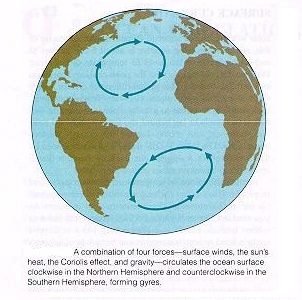
The Gulf Stream
carries the ark from the eastern coast of North America into the North
Atlantic. The ancient analogue of the North Atlantic Drift Current carries the ark
eastward and southward to the
Gibraltar Strait, where wind from the west moves the ark towards the Mediterranean.
The clockwise rotation of the North Atlantic Gyre is due to
Coriolis Effect,
resulting from the planet’s rotation. Curiously, ancient Book of Mormon people understood the earth to be in motion.
(Alma 30:44)
From the eastern coast of ancient North America, the Gulf Stream and
prevailing winds would have carried the ark northeast into the North
Atlantic. The great natural circuit of current would eventually bring the
ark eastward and southward to the latitude of the Mediterranean’s narrow
opening. It is possible for wind to blow from the Atlantic towards the
strait, and the Mediterranean Sea. This brings us to the interesting verse that begins Bereshit chapter 8:
“AND God remembered Noah, and every living thing, and all the cattle that was with him in the ark: and God made a wind to pass over the earth
[land], and the waters asswaged [Heb. “yashoku”,
from “shakhakh”,
a primitive root which not only means “subside”, but “weave”, as in to “weave” or “lay” a trap.
Indeed, the ark would be trapped in the waters of the interconnected inland seas.]” (Genesis 8:1, KJV)
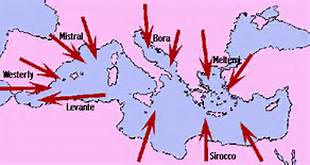
Note the Westerly Wind blowing from the Atlantic (left) towards the Mediterranean.
The wind upon the land (mentioned in verse 1 of chapter 8) occurred sometime
before the ark made landfall. Is this verse
suggesting that the occupants of the ark thought that a wind had something to do with the sight of land? How else would they have concluded that the waters were abating? The verse in fact refers to “ruah al ha-arets”, literally “wind upon the land”.
Its interesting to note that the verse does not make direct mention of the wind upon the
waters.
This raises a crucial question: If the ark could not be sailed and steered by human hands, how was she guided? Did the
Elohim prepare some means of guiding the great vessel through watery
straits? Did not
the Eternal perform a similar service in leading the children of Yisra'El
to their covenant land? He led them by his messenger, in a cloud by day, and a pillar of fire by night. He led them by extraordinary means through watery straits,
emblematic of rebirth?
LDS scripture states that “Enoch saw that Noah built an ark; and that the Lord smiled upon it, and held it in his own hand.”
(Moses 7:43) It stands to reason that the ark was not intended to drift aimlessly on the waters. The great vessel must have been
endowed with some form of internal or external guidance at crucial times.
Tehilah (Ps.)
104:1-9 reads: “Bless, O my Soul,
the Eternal,
…
who maketh clouds his chariot, who walketh upon wings of the wind.
Who maketh his messengers winds; his ministers flaming fire. Who
laid the foundations of the land ... Thou coverest her with the deep as with
a garment: the waters stood above the hills ... Thou hast set a bound
that they may not pass; that they turn not again to cover the land.”
A heavenly “merkavah” is a “chariot” associated with wind, cloud, and fire.
(2 Melakhim (2 Kgs.) 2:11, YehezqEl
(Ezek.) 1:4-28) Did a merkavah appear to guide the ark through narrow seaways to the flooded region of the Black Sea? If so, the occasional sighting of obscure and distant coasts,
after the ocean voyage, may have given the occupants of the
ark the impression that the waters were continually abating from off the face of the land.
(Bereshit (Gen.)
8:3) That being said, there may truly have been a rise and decline in sea
level.
“And the waters returned from off the earth [land] continually: and after the end of the hundred and fifty days the waters were abated [diminished].” (Genesis 8:3, KJV)
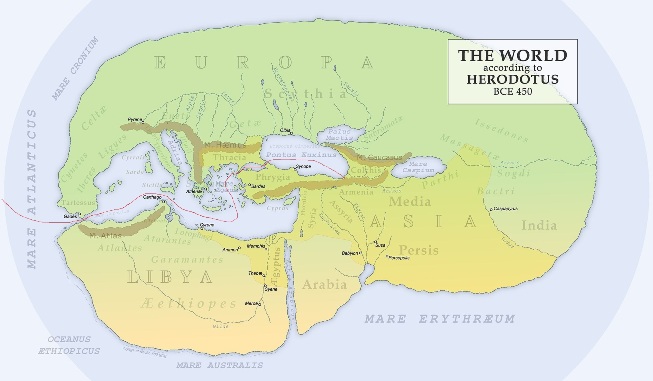
Voyage of the ark (red) guided by merkavah
(divine chariot of wind, cloud and fire) - adapted from a map of the world
based on the understanding of the Greek historian
Horodotus.
Note that the ark comes to rest in the center, or womb of the world (the
precise
Ararat location uncertain). As a Book of Mormon aside: note on the Herodotus map “Mare Erythraeum”
(Erythraean Sea).
The Latinized name of this sea coincidentally sounds a little like the Book of Mormon name “Irreantum”
(1 Nephi 17:5). “Irreantum”
is loosely interpreted “many waters”, but could in fact be a Hebraic expression
using the
plural of the Egyptian loanword
“y'or”,
in
“Yore-ayin-t’hom”, meaning “watercourses of the fountain of the deep”.
See Proverbs 8:28, and
Notes [ד , ה , ו].
The “mabul” (destruction) began “in the second month, the seventeenth day of the month” (Genesis 7:11,
KJV). We are talking about months of 30 days each, counted
perhaps, in the absence
of lunar observation. Twelve of Noah’s months constituted a 360 day year. So, from the beginning of the “mabul” to the ark’s landing “upon the mountains [hills] of Ararat”, five months, or about 150 days had passed.
The Hebrew expression “yahsru ha-mayim” translated “the waters were abated” is more correctly translated “the waters diminished”. Waters were still receding around the ark when the great vessel came to rest. Atmospheric conditions may have prevented the occupants of the ark from seeing more distant dry land. The waters of the Black Sea flood continued to diminish in the vicinity of the ark until the tenth month when “the tops of the mountains were seen.”
(Genesis 8:5, KJV)
“And the ark rested in the seventh month, on the seventeenth day of the month, upon the mountains of [Heb. “harei”,
possibly “hills of”, there is no definite article justifying “the”] Ararat.
And the waters decreased continually until the tenth month: in the tenth month, on the first day of the month, were the tops of the mountains [Heb. “he-harim”]
seen.” (Genesis 8:4-5, KJV)
Here the interesting account states that the ark “rested” (Heb. “tanah”,
which has the same root as the name “Noah”, meaning
comfort,
rest) upon “harei Ararat”, which can literally mean “hills of Ararat”; and that before long “rashe he-harim”, “tops of the mountains” (KJV) were visible.
The Prophet Joseph Smith, in translating the Bible, rendered the verse to read, “… upon the
Mountain
[singular] of Arrarat.” (Joseph Smith OLD TESTAMENT MANUSCRIPT 2, Page 29
(Genesis 7:13 - 8:11) ,
JOSEPH SMITH’S NEW TRANSLATION OF THE BIBLE - ORIGINAL MANUSCRIPTS, Edited by Scott H. Faulring,
Kent P. Jackson, and Robert J. Matthews, pg. 628; Inspired Version, Genesis 8:49)
But there really is no definite article in this case. Translating Joseph
Smith’s change into Hebrew just gives “har Ararat”. This can simply mean “a hill of Ararat”, since the word
“har”
can mean “hill” as well as “mountain”. Notice that Joseph Smith did not mimic the terminology
of Josiah Priest in this case. Joseph Smith didn’t write “Mount Ararat”
as Priest did. Torah does not say that the
ark came to rest on Mount Ararat, but on “mountains [hills] of Ararat”. It’s worth noting that “the mountains of Adam-ondi-Ahman” in North America
(LDS Doctrine and Covenants 117:8) are actually more like hills.
By the way, Joseph Smith’s translation earlier recorded, “... the Mountains of
Arae Arrarat”. (Joseph Smith OLD TESTAMENT MANUSCRIPT 1, Page 22 (Genesis 7:11 - 8:11), JOSEPH SMITH’S NEW TRANSLATION OF THE BIBLE - ORIGINAL MANUSCRIPTS, Edited by Scott H. Faulring,
Kent P. Jackson, and Robert J. Matthews, pg. 114) The second-century BCE Book of
Jubilees records that the ark “rested upon the top of Lûbâr,
one of the mountains of Ararat”, and that the same mountain (hill) is the
burial site of Noah. (Jubilees V.26, X.13)
Atmospheric conditions for making observation over long distances are not described in the Genesis flood account. The results of Noah sending forth birds from the
ark was interpreted as evidence that waters were on the face of “kol ha-arets”
(all the land). How could the waters be “on the face of the whole earth” (Genesis 8:9,
KJV), with mountain tops already seen (noted earlier, Genesis 8:5)?
The controversy subsides when we realize that “kol ha-arets” (all the
land) just refers to a local region.
After seeing the tops of “he-harim”, “the mountains”, many days passed before Noah sent out birds from the
ark. The purpose of sending out the birds was to acquire knowledge about the condition of “ha-adamah”, “the ground” remotely. Was the water level “ha-qlu”,
trifling?
Was it
slight at distances far away from the ark? The Hebrew expression is translated “to see if the waters were abated.”
(Genesis 8:8,
KJV)
When the dove at length returned with “an olive leaf plucked off” (KJV), “Noah knew that the waters were abated [made
trifling, diminished to the point of being slight] from off the earth [land].” (Genesis 8:11,
KJV) This didn’t mean that the ground was dry and passable.
If the birds first flew in the direction of the Black Sea, they may have
missed the chance to land on the mountains that had been seen. With the dove’s return, it was concluded that “the waters
were on the face of the whole earth [land]”. The whole land in question must have excluded the visible mountains. Verse 9 seems to be telling us that “the whole earth [land]” that was still wet into the 11th month, included the ground around the ark.
Near the end of the 11th month the waters were described as “qalu”
(they were
slight) upon “ha-arets [the land]”. From this point it would be a little more than a month before “ha-arets [the land]” was dry. It was then that Noah saw that the face of “ha-adamah” (the ground) around the ark was dry.
(Genesis 8:13,
KJV) That the emerging landscape, and the ground around the ark
dried at about the same rate, and that mountains had been seen months
earlier, fits a scenario in which the ark landed on an inundated hill not far from
what would be the coast of the receding inland sea. The ark did not land on a rocky summit of a majestic volcanic mountain.
A flood in the Black Sea region allowed the ark to float sufficiently southward and eastward to a hillside among other baptized hills, in a country that the Hebrews would come to know as
Ararat (ancient Armenia, 2 Melakhim (2 Kgs.) 19:37,
YirmeYahu (Jer.)
51:27). It is worth considering that the Genesis account never refers to the
receding waters upon the land of Ararat as “the waters of the flood”, “mei ha-mabul”? The rising waters of
the destroying storm, “mei ha-mabul”
are plainly mentioned in Genesis 7:10?
This is consistent with the understanding that the destroying storm, “ha-mabul”,
spoken of in scripture, impacted a coast of ancient America, not Armenia.
The Black Sea flood was a different flood. LDS Scripture appropriately makes
mention of “floods” (plural), which may intend more than one
source of water, and more than one geographic
location. Consider Moses 7:34,
38,
43,
50,
51;
8:17,
24.
The dove returning with a snipped olive leaf in her mouth can be seen as
evidence that the Black Sea flood was limited after all. A geographically
limited flood also explains the
existence of post-flood “giants” (“nephilim”, “rephaim” etc.)
not listed among
the descendants of Noah in the
Table of Nations.
(Bemidbar (Num.)
13:33, Devarim (Deut.) 2:20;
3:11)
The famous Tigris and Euphrates rivers were still in
existence after the days of Noah. How did the Mesopotamian rivers of
Eden survive the “Great Deluge”? The answer is before us: The floods of Noah
impacted North America and the Black Sea region. These inundations did not
reach all heights or cover all plains of the planet.
Only in the sense that these massive, but regional floods swept both the New
World and the Old World, at about the same time, can we think of them as global. Perhaps they shared a similar, if not a common
cause. A colossal wave from a meteor impact in the water could have rushed
through the Bosporus Strait. But its also possible that melt waters
descended into the Black Sea basin from snow and ice covered lands
of the
north.
You will note that during “the floods”, someone on board the ark was keeping track of the
passage of “days”. Clearly, God didn't cause the “mabul”
by stopping the rotation of the planet. Of course, even a slight change in
the planet’s rotation, due to impact, might send the seas sloshing
on a global scale!
What became of the ark’s American animals?
Many animals carried aboard the ark, and tended, or released upon the land,
probably mixed with local animals of their kind in the Eastern Hemisphere.
Others may have eventually become
extinct, or acquired the means to adapt and evolve.
Did Noah carry horses aboard the ark? The horse
appeared in the Eastern Hemisphere, but actually evolved from
Eohippus in North
America.
Evidence for the evolution of the horse is compelling. The
question
remains; is random mutation and natural selection
sufficient to account for all the diversity and complexity of life on this
planet? Can beneficial mutations be the result of decisions made in a
living microcosm - a universe alive on levels even smaller than organic
molecules? In other words, is life intrinsic to the material universe?
Horses are believed to have disappeared in North America sometime after the
last ice age. But the fact is, the vast majority of animals that die do not enter the fossil
record. It is difficult to say for certain how long horses survived in
America, and what exactly caused their presumed disappearance. A small number of
these animals could have been re-introduced into a limited region of North
America and tended during archaic Book of Mormon times. (1 Nephi 18:25)
The family of
Lehi (לֶחׅי, “Lehi”)
was not the first to inherit the
covenant land
(Ether 9:16-19)
on which they found ha-sus (הַסוּס,
“the horse”). Having just arrived in America from the Eastern Hemisphere,
Lehi’s company certainly knew a horse
when they saw one. Torah taught them to distinguish the horse from other
species that they were permitted to rely on for food. (Leviticus 11:1-7) Predation could have
caused the disappearance of these, and other domesticated animals noted in the Book of Mormon.
On the other hand, a limited number of horses may have survive after Book of Mormon times in the care of humans.
See "Ojibway spirit horses ...,
"Ojibway horses are endangered...",
"About the Breed", and "The Relationship Between the Indigenous Peoples of the Americas and the Horse: Deconstructing a Eurocentric Myth".
Deluge boats
Hard covered vessels carrying people and animals were part of the ancient world,
and not just in legend and myth.
Practical versions of these vessels actually existed. Noah’s
ark was in may respects a larger version of one of these types of craft. An
important distinction is that the ark was designed to survive an epic near-extinction
event.
(See Hugh Nibley, An Approach to the Book of Mormon, pp. 346-348)
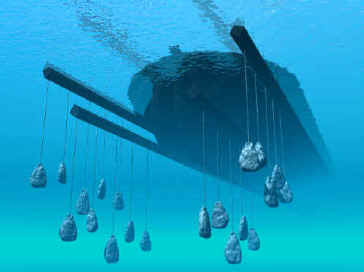
Deluge boat with stabilizing drogue stones aft.
Floodplain of Mesopotamia
Throughout the millennia, Mesopotamia has experienced numerous floods. An apocryphal
Sepher ha-Yasher (Book of Jasher) mentions a Mesopotamian flood that occurred before the time of Noah. (Jasher 2:6) The existence of
Mesopotamian flood stories older than the revealed Hebrew account
should not
surprise us. Why should we think that these older stories are more original?
Why can’t pagan flood legends (not just the Mesopotamian versions)
be localized adaptations of an account that came from America and the Black
Sea region? Of course, there could have actually been a Mesopotamian Utnapishtim who built a great floating structure to save his family, local villagers, and animals from a flood.
This does not mean that Mesopotamian flood legends were not conflated with
an earlier form of
the Noah story.
The account of Noah and “the destroying storm of waters” was doubtless passed on to
Avram (אַבְרׇם, “Abram”). The authentic Ur of Avram
may actually have situated in the Hurrian Ledge
at the northern arch of the Fertile Crescent, southward from where Hebrew scripture says the ark
came to rest. The true “Ur-kasdim”
(Ur of Avram) may in fact have been “Urkesh” near
“Haran”, and not any of the similar sounding sites in southern Mesopotamia. (Berlyn, Patricia,
“The
Journey of Terah: To Ur-Kasdim or Urkesh?”, Jewish Bible Quarterly; See also Hoskisson, Paul Y.,
“Where Was the Ur of Abraham?”,
Ensign, July 1991, pp. 62-63)
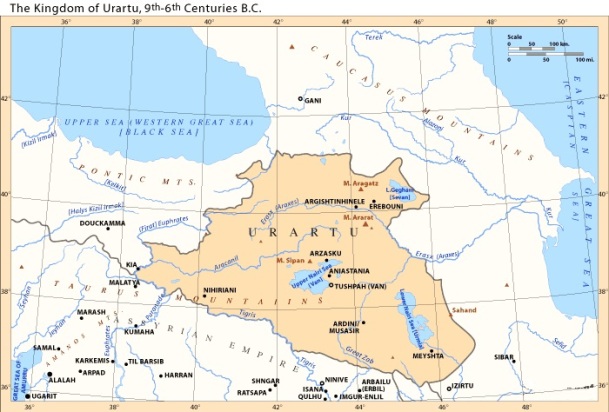
The Ancient Land of Ararat (Urartu), between great eastern and western seas, extends northward to hill country near the shore of the Black Sea, “Western Great Sea”.
Note that Avram’s Haran (“Harran”) is
just to the southwest. It may only be coincidence that the name “Ararat” sounds a little like
the Hebrew word “arets” (land).
What was the speed of Tevat Noah (Noah’s Ark)?
Taking LDS scripture as our guide, we conclude that it took the ark about 150 - 40 = 110 days to arrive on “the mountain
[hill] of Ararat” (JST). Accepting that the ark began her
voyage from the east coast of North America “near what is now South
Carolina” we may determine the distance to Ararat on the surface of a globe.
The distance from South Carolina, following the arc of ocean current to seas near the
strait of Gibraltar, and from there eastward through the Mediterranean Sea,
then though the Aegean, Marmara, and Black Sea to a southeast landing
(Armenia), is about 6,600 miles. To make this voyage in 110
days would requires an average speed of about 2.5 miles per hour. This is a
remarkably reasonable result, when averaging the speed of the Gulf Stream with slower North Atlantic currents, and considering that the ark was essentially a semi submerged barge. There is no hint of
sails, oars or rudder in the verses that describe the ark’s construction.
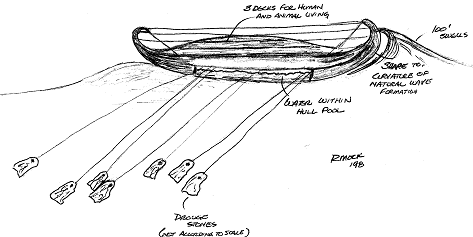
The ark as a deluge boat with open
“Hull Pool” on the bottom and stabilizing “Drogue Stones”
(sea anchors)
If on the other hand, we wish to be contrarian and suppose that the ark
landed in southern Mesopotamia, then the vessel would have had to progress
from the coast of North America into seas south of the equator (contrary to
ocean currents and prevailing winds), round the tempestuous horn of Africa,
and plow the Indian Ocean and Arabian Sea to the Persian Gulf; ostensibly towed all the while by
divine merkavim. Such a voyage, at a minimum, would amount to about 12,700
miles (measured on a globe). To make this voyage in 110 days would require
an average speed of about 4.8 miles per hour; which is possible for a vessel
having some means of guidance and independent propulsion.
Shorter non-scriptural voyages for the ark, might conjecture
that the great vessel landed on a slope of Mount Etna,
or Mount Parnassus,
or Mount Athos. These
are alleged landing sites of Deucalion’s
ark, according to Greek Flood myth.
Noah’s scripturally consistent voyage to the
Black Sea would have
passed by each of these sites.
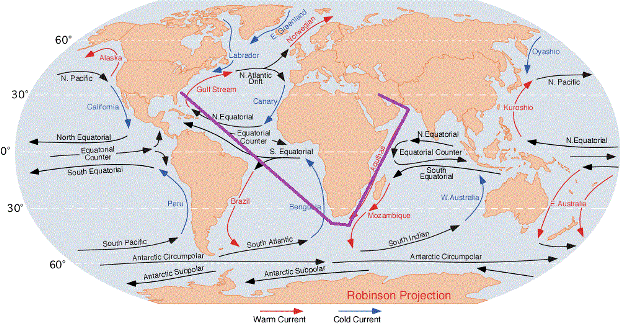
Supposing the American ark landed on a southern shore of Mesopotamia
(rather than scriptural Ararat), the shortest course (~12,700 miles) at sea,
from South Carolina, would require steerage and propulsion capable of
maintaining an average speed of about 5 mph against prevailing winds and
currents, in order to reach the Persian Gulf in the scriptural 110 days. We
consider here a tevah (ark), that is almost never guided by
nature (teva)
i.e. sea current and
prevailing wind.
Contrast this unscriptural voyage with the proposed voyage of Lehi’s
company which launched from a southern coast of Arabia, and sailed southward
with the current along the coast of Africa.
Surviving the tempestuous seas off Africa's
southern cape
(1 Nephi 18:13-14),
currents and prevailing winds could have carried Lehi’s company to the
eastern coast of temperate North America, where they found waterways in the
north that
led “into the promised land”.
Ha-Yeredim (The Jaredites)
The Yeredim (Jaredites) of the Book of Mormon, more or less
accomplished the voyage of Noah in reverse. These ancient people journeyed from the region of the Black Sea
(Ether 2:1,
4-7)
to “the lake country of America”, a term employed by Josiah Priest and
Joseph Smith to describe the Great Lakes region (Lake Ontario in
particular). The Yeredi (Jaredite) baptiscaphs (baptismal boats) or “barges” must have followed the arc of the
Canary and slow
Equatorial currents around to the eastern coast of North America.
There the Gulf Stream would have swept them northward to the mouth of the
Saint Lawrence.
The Saint Lawrence River leads to “the lake country of
America”, the region where Joseph Smith said these ancient people arrived. (See “Traits of the Mosaic History found among the Azteca Nations”,
Times and Seasons, Vol. 3, June 15, 1842, Joseph Smith Ed.) See
also Notes [ב , ג].
The Book of Mormon people of Nephi, who built great works of earth
and timber, apparently unearthed fossil evidence of
“elephants”,
and their use by antediluvian “man”. Western New York, the authentic literary setting for
the Book of
Mormon, abounds with such remains.
It would have been natural for some of Nephiim (Nephites) to suppose
that the megafauna were contemporary with the extinct Yeredi
(Jaredite) nation.
It is
extremely unlikely that the Yeredim carried elephants to America aboard their small barges.
(Ether 2:16-17;
6:4) It
is
nevertheless true, that “there were elephants ... which were useful unto man”
in New York - prehistoric New York! (Ether 9:19)
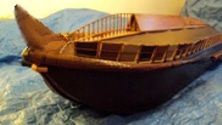
Deluge Barge (8 foot model made by V. Coon)
We are left free to decide which side of the globe best qualifies as “the New World”. To Noah
and his family, America had become a world of fallen sons of men, and wicked nephilim
- an old world left behind in the storm. (2 Peter 2:5)
Notes
[א]
Footnote d added to
LDS Doctrine and Covenants 133:24 suggests an antediluvian division
of the continents in the days of Peleg. This is not a scriptural fact. Comparing verses from
Hebrew scripture, it becomes clear that “the earth divided” (KJV) in
the days of Peleg simply means the division of the inhabitants of
the land. THE NEW-BROWN-DRIVER-BRIGGS-GESENIUS HEBREW AND
ENGLISH LEXICON entry 776 c. notes several examples
of “earth = inhabitants of earth” and cites several
scriptural examples: Genesis 6:11;
11:1,
1 Kings 2:2;
10:24,
Psalm 33:8 etc.
In the Authorized Version of the LDS
SCRIPTURES with Official Study Aids (CD ROM RESOURCE EDITION 1.0)
we find:
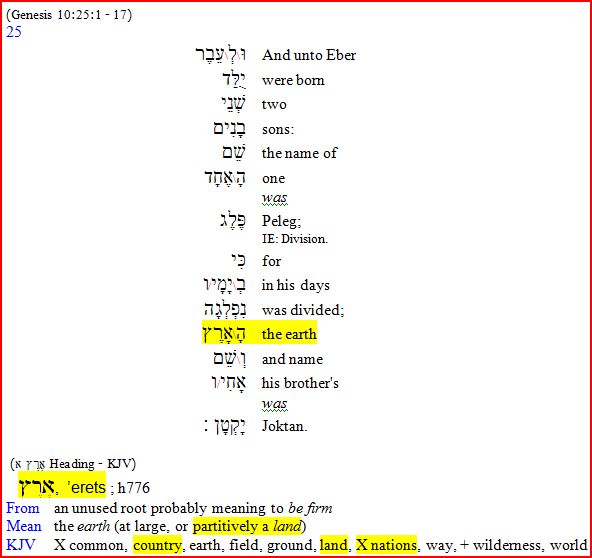
Of course, Revelation 6:14 prophesies: “…and
every mountain and island were moved out of their places.”
LDS Doctrine and Covenants 133:23-24 prophesies: “He shall
command the great deep, and it shall be driven back into the north
countries, and the islands shall become one land; And the
land of Jerusalem and the land of Zion shall be turned back into
their own place, and the earth shall be like as it was in the
days before it was divided.”
But note that these verses do not
mention the biblical character Peleg!
It may be helpful to understand that the Hebrew
word translated “isle” can mean “coast” as in continental coast.
True islands can form independent of continents and were generally never
part of “one land”.
Concerning the age of the Earth:
The “seven thousand years of [the earth’s]
continuance, or its temporal existence”
(LDS Doctrine and Covenants 77:6) is measured according to the temporal
“reckoning” of “Adam”. (Abraham 5:13) Adam’s (mankind’s)
reckoning ostensibly commenced at the time of the expulsion from the
Garden of Eden. The geological age of the world in which we now live
is much greater than seven thousand years.
[ב]
In the Authorized Version of the LDS SCRIPTURES
with Official Study Aids (CD ROM RESOURCE EDITION 1.0) we find:
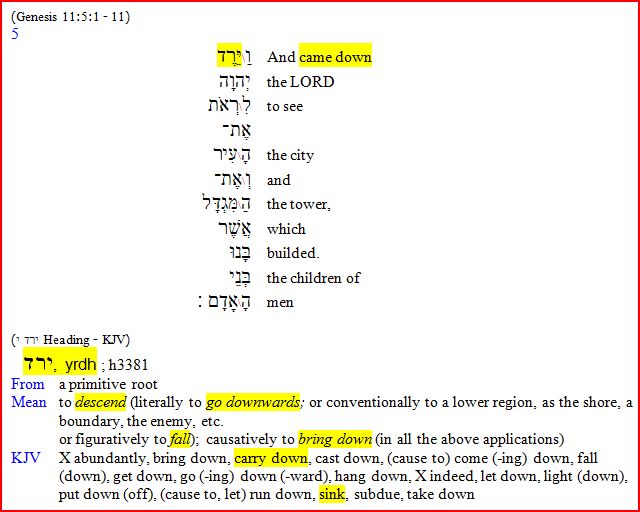
On the scriptural significance of the meaning of “yered” (i.e. Jared, Jaredites), see Ether 1:42;
2:1-4 etc.
[ג]
In the Authorized Version of the LDS SCRIPTURES
with Official Study Aids (CD ROM RESOURCE EDITION 1.0) we find:
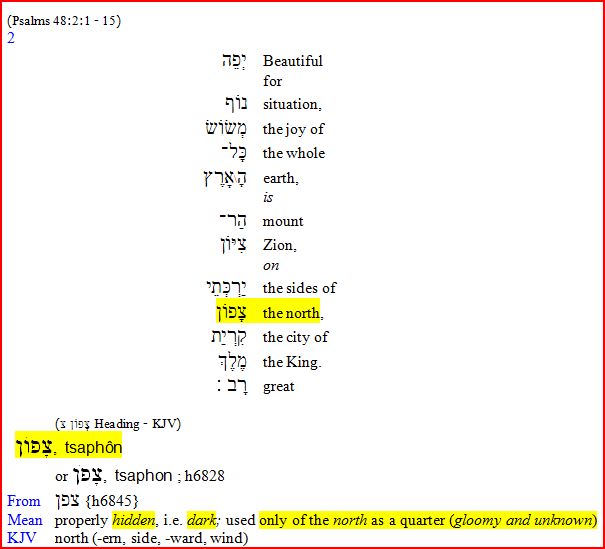
Ethan Smith, wrote the following as touching on the topic of a post-flood uninhabited northern land noted in Jewish
apocrypha (The Tribes of Israel in
America, a.k.a. A
View of the Hebrews, 1825 edition, pp. 74-75):
“3. We have an account of the ten tribes, after
their captivity, which accords with the ideas just stated. We receive not
the books of the Apocrypha as given by Inspiration; but much credit has been
given to historical facts recorded in it; as in the wars of the Maccabees,
and other places. In 2 Esdras xiii. 40, and on, we read; "Those are the ten
tribes which were carried away prisoners out of their own land, in this time
of Osea, the king, whom Salmanezer, the king of Assyria, led away captive;
and he carried them over the waters, and so came they into another land."
Here is the planting of them over the Euphrates,
in Media. The writer adds; "But they took this counsel among themselves,
that they would leave the multitude of the heathen, and go forth into a
OF JUDAH
AND ISRAEL.
75
further country, where never man dwelt; that they might there keep
their statutes which they never kept (i.e. uniformly a s they ought,) in
their own land. -- There was a great way to go, namely, of a year and a
half." The writer proceeds to speak of the name of the region being
called Asareth, or Ararat. He must allude here to the region to which they
directed their course to go this year and a half's journey. This place where
no man dwelt, must of course have been unknown by any name. But Ararat, or
Armenia, lay north of the place
where the ten tribes
were planted when carried from Palestine.
Their
journey then, was to the north, or north-east. This writer says, "They
entered into the Euphrates by the narrow
passages of the river." He must mean, they repassed this river in its upper
regions, or small streams, away toward Georgia; and hence must have
taken their course between the Black and Caspian seas.
This set them
off north- east of the Ararat, which he mentions. Though this chapter in
Esdras be a kind of prophecy, in which we place not confidence; yet the
allusion to facts learned by the author, no doubt may be correct. And this
seems just such an event as might be expected, had God indeed determined to
separate them from the rest of the idolatrous world, and banish them by
themselves, in a land where no man dwelt since the flood.”
Regarding the “northward” trek of the Yeredim (Jaredites), their coming to a “quarter where never had man been [since the flood]”,
their arriving a the shores of “the sea in the wilderness”, see
Ether 2:1-7.
[ד]
In the Authorized Version of the LDS SCRIPTURES
with Official Study Aids (CD ROM RESOURCE EDITION 1.0) we find:
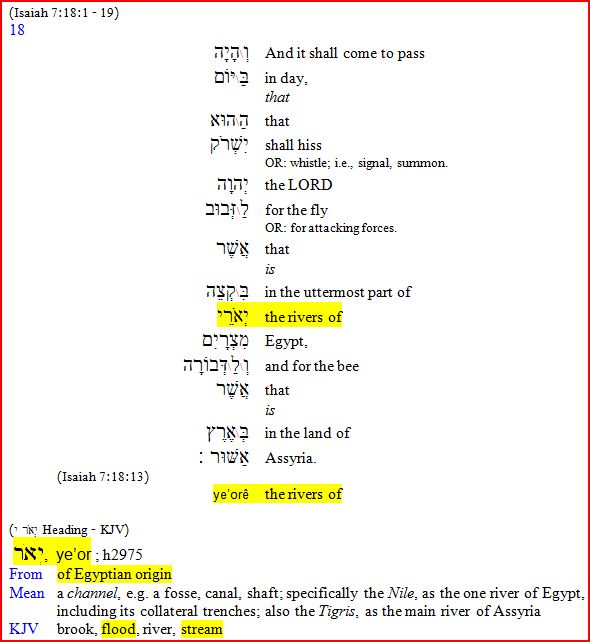
THE NEW-BROWN-DRIVER-BRIGGS-GESENIUS HEBREW AND
ENGLISH LEXICON entry 2975 notes: “Egypt.loanword … ‘io’r,
watercourse”
[ה]
In the Authorized Version of the LDS SCRIPTURES
with Official Study Aids (CD ROM RESOURCE EDITION 1.0) we find:
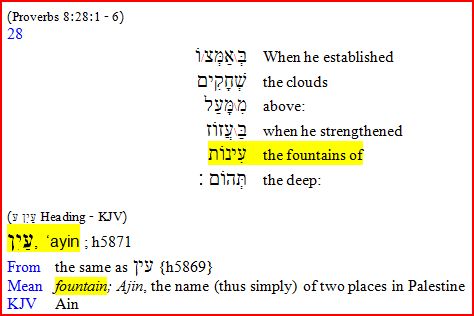
[ו]
In the Authorized Version of the LDS SCRIPTURES
with Official Study Aids (CD ROM RESOURCE EDITION 1.0) we find:
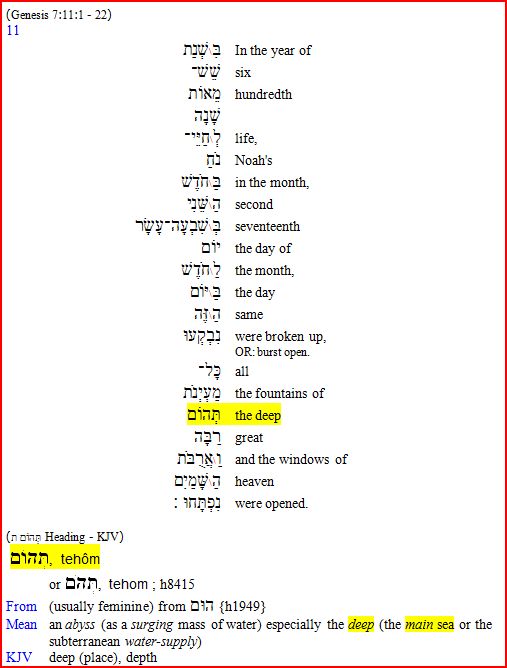
[ז]
In the Authorized Version of the LDS SCRIPTURES
with Official Study Aids (CD ROM RESOURCE EDITION 1.0) we find:
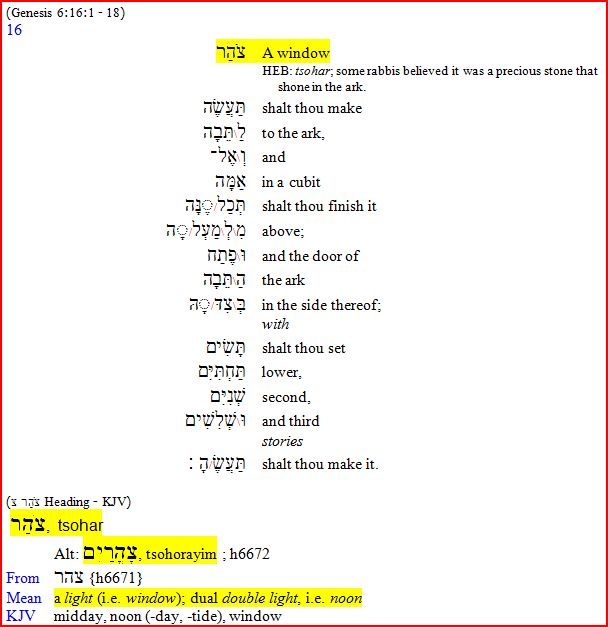
[ח]
In the Authorized Version of the LDS SCRIPTURES
with Official Study Aids (CD ROM RESOURCE EDITION 1.0) we find:
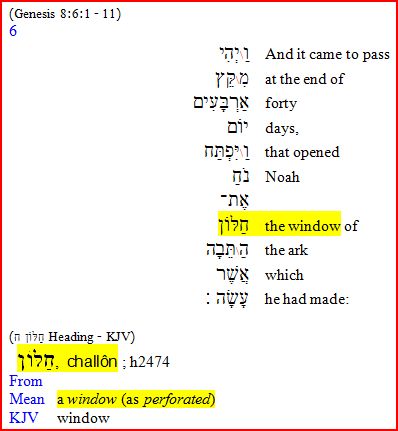
Return to
The 344 Day VOYAGE of the JAREDITES
|
Vincent Coon
ו֣ינ֤סֶנ֤ט כּוּן
© Copyright 2017 |
|